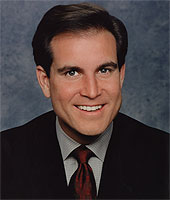Ray Bribiesca talks to students in the Hall of Fame Room in Gaylord Hall on Nov. 1
Ray Bribiesca, an award-winning photojournalist for "60 Minutes," spoke to students at the Gaylord College of Journalism and Mass Communication Monday, Nov. 1 about his extensive career in news and documentary reporting.
More than 46 years of television news, production and photojournalism has taken Bribiesca on a "great, great ride": He has won several Emmys for his work and was recently awarded the Peabody Award for "significant and meritorious achievement in electronic media." In his spare time, Bribiesca says he likes shooting wildlife photography.
Bribiesca has been shooting combat for all 46 years of his career and has worked with CBS for more than three decades. Ever since Bribiesca enlisted with the U.S. Marine Corps for the Vietnam war, he has had a camera on and the film rolling. To this day, his camera is always on hand.
"My camera is in the car," he said. "I never go anywhere without it."
He described combat as a chaotic and difficult setting. To capture it on video without getting seriously injured is perhaps even more difficult.
"The tension is building, building, building, and you're just waiting for it," correspondent Lara Logan, who most recently worked with Bribiesca on his latest "60 Minutes" segment, in a video interview on CBS.com.

Bribiesca himself defines some of the shots he gets during combat as "crazy shots." He admits that when his family, relatives and close friends see them during production of his stories, they think "crazy shots." On the contrary, audiences are captivated by the footage captured by Bribiesca. His shots are not stock, over-the-shoulder combat sequences the public usually sees during a war package. His rare shots show soldiers positioning and their faces during combat, capturing often unseen human emotions.
"Those [the crazy shots] are the shots that when I see combat I always say, 'What does the face look like?'" Bribiesca said. He said shoots while keeping a mental clock counting in his head until he can answer the question "Do I have it?"
These shots obviously put Bribiesca in harm's way, but he attributes his vault of combat knowledge to put himself in places that provide him the best location to shoot the footage and not recklessly get himself shot.
Lara Logan said she admires Bribiesca for his commitment to his work and his self-control when the shooting commences through the battle, sometimes for more than 30 minutes at a time.
"Ray was just standing there...calmly filming everything," Logan said. "He wasn't reckless, he wasn't stupid, he just wasn't afraid."
Bribiesca said that he does not plan what he wants to shoot before the action happens. He also says that he is not looking for one particular shot. He is actively documenting the battle.
"You just react," he simply said. "I'm literally taking positions of soldiers in the field."
Bribiesca's "great, great ride" is soon reaching its end. Bribiesca is currently filming his last story for "60 Minutes" in Yemen. While this is his last story for CBS, this will not be the last assignment he will ever work on.
"I'll still be out there," he said.
At the completion of this last assignment for CBS, Bribiesca will begin working for National Geographic in search for the nature shots he is still pursuing in his free time.

Ray Bribiesca talks to students about his experiences shooting combat
PHOTOS: ZACK HEDRICK








.jpg)


